Puerto Rico, USA!

Jenna staring out from Flamenco Beach on Culebra Island, considered one of the five best beaches in the world.

Our destinations were the two islands immediately east of Puerto Rico: Vieques and Culebra, outlined above in green.
We didn't stay in San Juan long, so I'll return to that city when we finish our islands tour. We flew on an Air Flamenco puddle jumper from a small airport south of San Juan (Isla Grande); it was just us and the pilot, Jaime, a fun-loving Puerto Rican who used to fly for United Airlines. (He's now 72; he was delighted that Ivan Rodriguez was about to be elected to baseball's HOF; though he was humbled after the Warriors had just routed his Cavaliers!) It was a 35-minute jaunt east to Vieques Island, a place Jenna wanted to visit but had not before.

Here's where we made our one mistake. We looked in advance to rent a vehicle, but the minimum was two days, and we only planned to stay 24 hours. Cheap bum dad, with Jenna agreeing, decided to taxi and hoof it. Bad move. While it might have been smarter to stay two days, and we could have seen a lot more of the island, it would have restricted our time on Culebra Island, our next stop. We got to the north side of Vieques early in the morning and took a cab down to Esperanza, down by Mosquito Bay. Because we couldn't check into our AirBNB until mid-afternoon, we had to wing it. Actually, hoof it. With our backpacks.
[Note: You can ferry over from the main island to both Vieques and Culebra, but the ferries leave a bit of a distance from San Juan (ergo, an expensive cab trip), and they are not very reliable. Besides, it's wonderful to see the area by air, and the plane rides are short and sweet. And relatively cheap. Good call, Jenna!]



Thanks for joining us on our trip!
Rick & Jenna

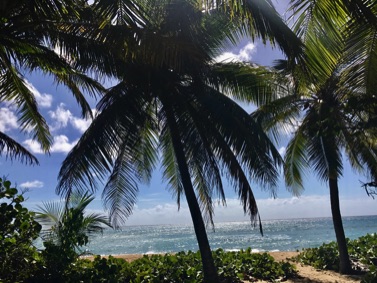

The taxi dropped us off at the Del Mar, an open-air breakfast bar in Esperanza. We recommend this place and Bananas (for dinner); avoid the BellyButtons, a menu that can be found at any bad sports bar in the states.
We wandered around this little seaside town, which was laid- back and funky (without feeling touristy). It reminded me a lot of the area south of Kona (Big Island), except these places are not chains. Many of the people are "ex-pats" from the Upper 48.
We had two main destinations on Vieques: The black beach and Mosquito Bay, home of (perhaps) the best bioluminescent bay in the world. The first would take a nice (as in long) hike along the highway west of Esperanza; the latter a short jaunt from our AirBNB.


After we checked in and had dinner, we took the short walk to Sun Bay, just after sunset (below). There we waited for our 7:30 p.m. kayak tour of Mosquito Bay. I do not have photos of the BioBay tour (a friend labeled it a BioYak trip, which is probably more descriptive), but that's because it simply is not conducive to amateur photgraphy. The photos below came from various sources.
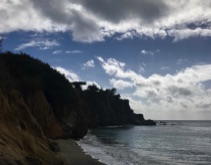

While I understand that the whiteness of my feet helps to make the sand look blacker, it really was a very black beach, with very fine sand.
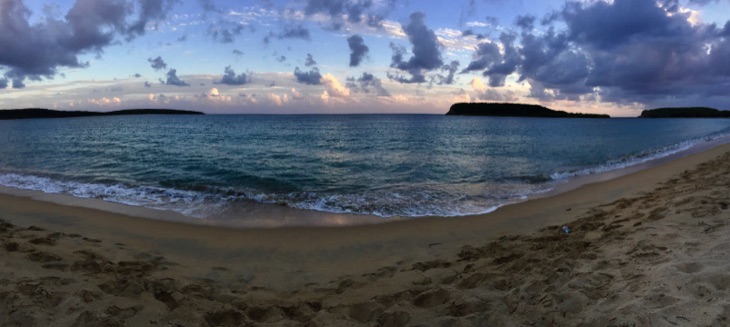
Other than getting to spend a quality relaxing week with daughter #2, the BioBay was the highlight of the trip. It is a must-do experience that deserves a place on all of your bucket lists. It was a relatively inexpensive ($49) tour that we would have gone on twice if we were on the island for two nights.
We oared out into the dark in double kayaks to a calm bay. You immediately realize that there must be headlights on the end of your oars! Every stroke brought a flash of light. If you trailed your finger in the water, the wake lit up. If you dipped your hand in the water, when you brought it out there were tiny lights along the back of your hand. If you flicked the water out across the bay, the drops would light up (we were told that a light rain brings out the best in the bay). All around you, the bioluminesence lit up as tiny fish darted here and there. A small school of fish would bring an explosion of light.



What up?
The conditions of the bay produce an enormous abundance of dinoflagallates (500,000 to a million per gallon of water), which react to "disturbances" in the water.
Each dinoflagallate, we were told, lights up about eight times a night; but there are so many in the water, there is an endless number of light shows all around you.
Then, you lay back a bit and look skyward. The entire sky is lit up in white with one of the most amazing views of stars and planets you might ever have seen. Our tour guide did a great job explaining the bioluminescent phenomenon, as well as pointing out the celestial sights.
Our only other annoyance on the island was the incessant crowing of the roosters at all hours of the night. And here I thought they only crowed at sunrise; perhaps, it was the near full moon that set them off. By the way, the BioBay tours do not operate during the five days surrounding the full moon; otherwise, the moon obscures the bioluminescence of the bay.
The next morning it was off to the small airport where Jaime again was there to take us on the short 15-minute flight to Culebra Island.


Having visited the island last year for a wedding, Jenna knew we had to have a golf cart to allow best access to the island. And she set us up in an AirBNB with a heckuva view of the inner bay.
After taking this couple's picture with this panoramic shot, I offered to text it them; they were delighted. And where were they from? They lived about 15 minutes away from Jenna in Chicago; the second Chicago couple we'd met that day. We spent time at this gorgeous beach - and in the surf - all three days we were in town.
About the only thing Flamenco Beach is not known for are its sunsets, so we took off for the west side of the island - Melones Beach - to snorkel and watch the sunset. It was here we met up with, again, a woman (Rodon) from New York whom we'd given a ride from another beach earlier that first day, plus several people she had met: Eduardo & Marie from Arizona/Washington, plus a young German traveler from Munich, Nicky. Jenna, Rodon & I went snorkeling, then all of us enjoyed the sunset. It wasn't long before we discovered Nicky's super talent: yoga! She's the tiny dancer below. Suffice it to say, the locals (and, again, many of them were from the U.S. mainland) and the tourists, many of whom were from the Midwest, were as friendly as could be.
We started with a self-guided tour of the island (note: it doesn't take long; we went from island end to end over three days, and it cost us only $7 to fill up the tank when we left; however, with all of the ups and downs of the island, it would have been a waste of time to try to walk or taxi everywhere or even rent bicycles). A jeep or golf cart rental is a must.
We finished our driving tour at one of the world's prettiest beaches: Flamenco.
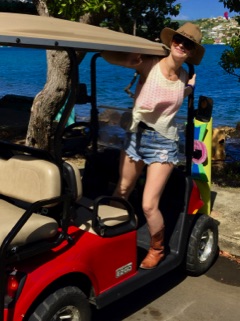


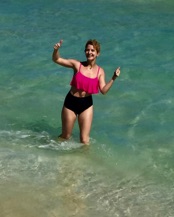




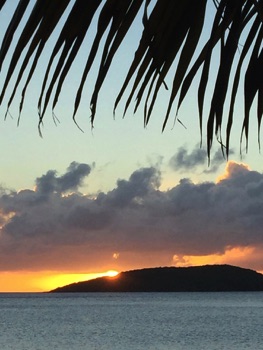

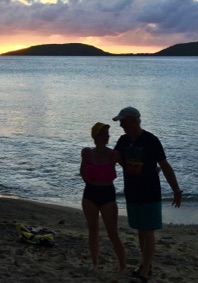
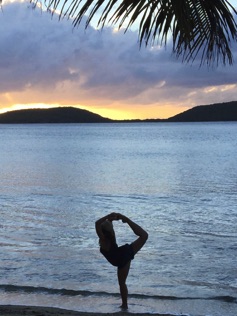
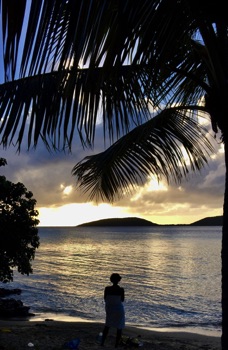
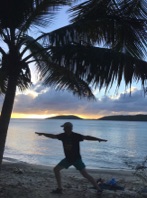

There are fun places to eat on the island. Jenna vowed we'd go to Zaco's Tacos every day, and we did; excellent tacos and burritos, Puerto Rican style. The Dinghy Dock had great local food and, as its name implies, it's right on the water where you can tie up your dinghy; at night, they feed tarpon along the dock (they're protected around the island), and they were very good sized. Great open-air places to eat and enjoy friendly waiters, bartenders, locals and tourists.

One last snorkeling trip before we headed back to Old San Juan; this is Tamarindo Beach, where Jenna snorkeled with sea turtles and a stingray.


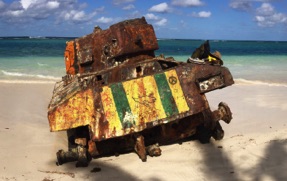
An old rusting Sherman tank on the far edge of Flamenco Beach; typical street art; and a view of the inner harbor; our AirBNB sits on the hill in the distance
Just before sunset on our third day, we hopped another Air Flamenco back to San Juan; Jenna got to ride as co-pilot; alas, not with Jaime at the controls! On the right is the tip of Old San Juan, Fort San Felipe del Morro.



It wasn't until we checked into our first San Juan Hotel, the delightful Da House on Calle San Francisco, that we learned that we would be returning to Old Town at the start of the largest festival in the entire Carribean: SanSe San Sebastian Street Festival. Sure enough, the taxi couldn't even make it into town; the streets were blocked off. After a short hike to our lodging, the okay-but-less-delightful Hotel Milano, we hit the streets and enjoyed the festivities. There were salsa bands all through town, with plenty of bars open and alcohol flowing freely. But it was not rowdy; people were dancing and having a great time. When the sounds of one band retreated, you'd pick up the sounds of the next band in the next park.
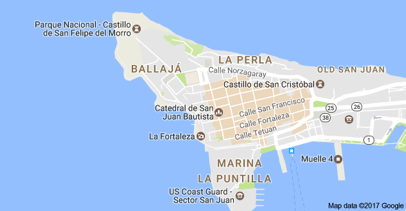

That night and the next morning, we hiked all over Old Town San Juan, enjoying the beauty of the streets and old buildings, the Fort and the dozens and dozens of cats we encountered (we're both cat people). Save a Gato is their local rescue program that takes care of the cats; they are well fed and given shelter and medical attention; plus, they are spayed. Enjoy the sights of Old San Juan.















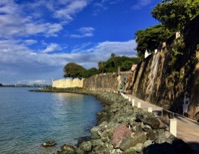
Jenna & Rick
Rodon
N
i
c
k
y
Jenna Rick
It started with a simple phone call: "Hey, dad, do you want to go to Cuba with me?
"Of course; when are we going?"
It was time for Jenna to plan her annual January pilgrimage out of the Chicago cold to some place warm. She and friends have been honoring their globe-trotting high school friend, Tommy, who died in a motorcycle accident five years ago. Her friends couldn't go, so I was next in line to ask (at least I think I was next in line).
It turned out the red tape to get to Cuba seemed excessive for a five-day trip, so Jenna settled on Puerto Rico. She had been the previous year to a friend's wedding, so she had a good idea of where to go (including a place she'd heard about and wanted to go). Worked for me. I'm usually the trip planner, so it was nice to have her take the lead.
Not only did she do great, but the trip convinced me this won't be my last trip to Puerto Rico. And that in spite of the four-hour time difference from the Left Coast.
We'll start with a short history and geography lesson. Puerto Rico (pop 3.5 million) is a territory of the United States (much like Hawaii & Alaska were prior to statehood in 1960, and similar to Guam, the U.S. Virgin Islands & American Somoa). The Treaty of Paris (1898) ceded Puerto Rico, Guam and the Phillipines to the U.S.; Puerto Rico started as an unincorporated territory and became a commonwealth (territory) in 1952; efforts by Puerto Ricans to become the 51st state have been rebuffed by Congress, and it is highly unlikely that will change in the near future.
The island is in the Atlantic Time Zone, one further east from the East Coast; Puerto Rico is 258 miles east of the Dominican Republic and 835 miles southest of Cuba.
We flew non-stop from Chicago to the capital city of San Juan (pop 390,000) and stayed in Old San Juan, the historic part of the city. Because we didn't stay long, we never made it out of the Old Town area.